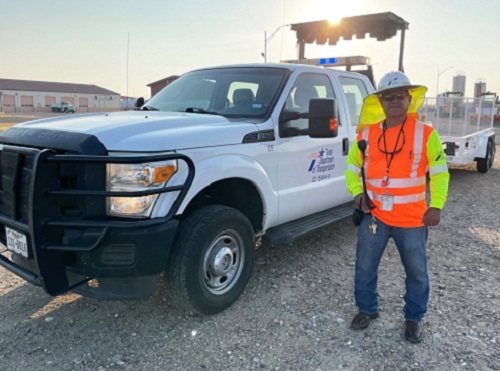The Transportation Research Board is hosting a webinar on February 9 that examines practices and trends state departments of transportation are deploying to improve highway worker safety.
[Above image by TxDOT]
This webinar – sponsored by TRB’s National Highway Cooperative Research Program – is based on NCHRP Synthesis 591: Use of Safety Management Systems in Managing Highway Maintenance Worker Safety and features a presentation by Samuel Salazar, occupational health safety manager at Texas Department of Transportation, along with presentations from health and safety experts from the University of Kentucky and Texas A&M University.

TRB noted in a statement that this webinar aims to detail the national state of practice on use of safety management systems, explain how TxDOT integrates and manages worker safety through their safety management system, and highlight new and advanced approaches to managing heat stress among state DOT work crews.
The safety of highway work crews is becoming a focal point for state DOTs due to an increase in highway work zone incursions over the last few years.
For example, a yearly survey conducted by the Associated General Contractors of America and software firm HCSS conducted in 2022 found that 64 percent of highway contractors said motor vehicles crashed into their construction work zones during the past year.
According to the survey, motorists are in even greater danger from work zone crashes versus construction workers. While 18 percent of the highway contractors participating in the survey experienced crashes that resulted in injury to their workers, more than twice as many firms – 41 percent – reported experiencing a crash in which vehicle drivers or passengers were injured.

[Editor’s note: The annual National Work Zone Awareness Week campaign is held every spring to coincide with the start of construction season to encourage safe driving through highway work zones. The 2023 NWZAW campaign – hosted by the Missouri Department of Transportation – will be held April 17-21. Click here to learn more.]
Motorists and their passengers are also twice as likely as highway workers to die in work zone crashes, the survey found. While 7 percent of contractors in the survey report that construction workers died in work zone crashes, 15 percent of survey respondents said drivers or passengers died in those crashes.
“The men and women of the construction industry are frequently working just a few feet, and sometimes inches, away from speeding vehicles,” said Ken Simonson, AGC’s chief economist and author of the annual survey, in a statement.

Simonson noted that 97 percent of contractors report that highway work zones are either as dangerous, or more dangerous, than they were a year ago. He said that figure is consistent with data released by the National Highway Traffic Safety Administration that reported motor vehicle fatalities rose to a 16-year high in 2021, according to preliminary data.
“In many cases, vehicle speeding contributes to these crashes in work zones,” added Steve McGough, president and CEO of HCSS. “Utilizing speed cameras with a zero-tolerance policy would go a long way to protect the traveling public and our workforce.”
AGC and HCSS based their report on a nationwide survey of highway construction firms conducted in April and May of 2022, with over 500 contractors participating in their annual poll.



